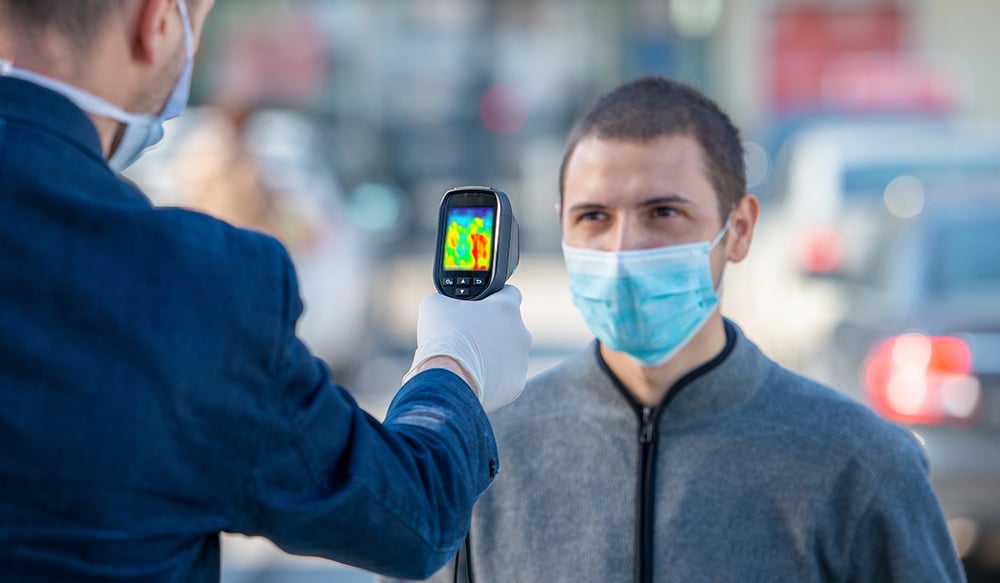Thermal Imaging Cameras: Fever Detection for COVID-19 Protection
Security Cameras Security Systems May 26, 2020 5:09:35 PM General Security 4 min read

As the world adjusts to new social and workplace protocols amidst the novel coronavirus (COVID-19) pandemic, organizations are anxious to resume business operations.
With personal protective equipment (PPE) now required for medical professionals and the general public, many tech devices have also pivoted to help thwart COVID-19’s spread, such as thermal imaging cameras.
Its advanced physical security components and infrared temperature sensor screening serve as significant physiological tools in identifying elevated body temperatures that could be related to associated infections.
Thermal imaging can’t diagnose nor prevent COVID-19 or any other virus. It can help control a possible outbreak by flagging those who may be feeling ill.
Here’s a useful breakdown of each recorder’s features, pros and cons, costs, and more:
Origins
Several tech companies originally developed thermal imaging cameras as infrared line scanners for the military.
They’ve evolved into useful heat source detection devices with a wide range of public safety applications—including firefighting, utilities monitoring, uncovering mold and leaks, and more.
The thermal imaging market is expected to grow even higher, as needs shift toward defeating COVID-19, limiting liability and safeguarding the public.
Temperature Measurements
Thermal imaging cameras and associated software capture and process images for immediate evaluation.
The human body and even inanimate objects absorb, reflect, and transmit energy, emitting heat or coldness. Unlike infrared or non-contact thermometers, handheld or mounted thermal imaging cameras can scan an individual’s forehead or tear ducts from a distance to determine body temperature.
The following protocols help determine such measurements:
- Employees are remotely monitored through specific screening checkpoints.
- Trained security professionals observe the camera’s on-screen color variations, indicating temperatures of 100.4 degrees or more. Accuracy is within +/- 0.5 degrees Celsius, according to the Institute of Electrical and Electronics Engineers.
- Higher readings appear in warmer tones such as red, orange, and yellow. Cooler temperatures are viewed as purple and blue.
- Green indicates a room temperature reading.
- Those with an elevated reading are moved to a separate area for additional screening by healthcare professionals.
Thermal imaging can’t diagnose nor prevent COVID-19 or any other virus. It can help control a possible outbreak by flagging those who may be feeling ill.
Benefits
Thermal imaging detects fevers that can lead to possible COVID-19 infections. While this can help reduce community spread, it cannot screen for the virus or antibodies.
These cameras can be used for individual spot-monitoring, and in dense areas for group checkpoints at grocery stores, hospitals, airports, offices, and retail environments.
Anyone with an elevated temperature would be directed to the aforementioned health professional screening area for additional observation.
Components
Thermal imaging cameras are ranked by their detector resolution and thermal sensitivity. The former is the camera’s pixel count, the latter focuses on lowest temperature difference.
Temperature range is another consideration, detecting the highest and lowest measured readings. Images are based on focus, emissivity, reflective temperature changes, and thermal tuning.
Types & Accessories
Thermal imaging cameras are available in various forms. The two most commonly used for fever detection are handheld and mounted. Both are ergonomically friendly and can easily capture information.
Handheld
This model offers optical and thermal imaging for enhanced viewing. It’s used for quick, individual spot screening at airports, office buildings, and other public areas.
Other features include video recording and image capture. Alerts sound when elevated readings are detected or don’t sync with customized alarm settings. The cameras connect to any desktop or mobile device through Wi-Fi and Bluetooth, and can be mounted to a tripod.
Mounted
These can be affixed to a tripod or wall for indoor and outdoor scanning in larger crowds. This is helpful for construction sites, parking garages, and stadiums. These cameras are also equipped with night vision.
Black Body Calibrator
This optional item attaches to the camera’s view field to increase temperature-reading accuracy.
Video Analytics
Additional cameras with video analytics software can be used to help enforce workplace social distancing requirements.
Privacy Concerns
Privacy advocates have raised concerns as thermal imaging technology is utilized more and more to enforce COVID-19 temperature monitoring and social distancing.
Both the U.S. Food and Drug Administration, and Equal Opportunity Employment Commission publicly support this technology, and the latter urges organizations to send fever-detected employees home.
Enlist our Expertise
We can draft a comprehensive plan on how thermal imaging technology fits into your commercial security plan, and develop a customized solution to meet the unique needs of your employees and business operations.
Request a free, contactless quote from us today.
General Security provides, installs, and monitors advanced commercial security systems across various industries throughout the United States.
